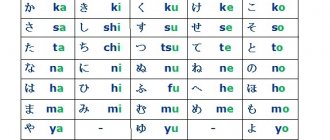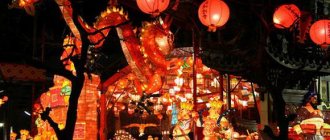The concept of death in Japan according to Buddhism and Shintoism
To briefly formulate the concept of death in Buddhism, it is a consequence of the disintegration of dharmas or a combination of properties, phenomena, substances, which are divided into 5 groups that contribute to the creation of a psychosomatic system (human). When this process is disrupted, a person ceases to exist in the physical shell. According to Buddhism, the main thing in human life is the desire for its rethinking and liberation. After the disintegration of dharmas, a new combination of them is formed. This facilitates the transition to a new life, which starts the process of reincarnation.
Shintoism is based on the belief that all things are animate. Devotees worship deities, but, in addition to them, also the souls of those who have passed away. The religion is based on manuscripts from ancient Japan. Death, according to Shintoism, is not considered bad, but it still violates the purity of the body, which interferes with participation in worship. Because of this, the dead were not buried on the territory of the temple, and traditional rituals were not performed over them.
THE RELIGIOUS TREND HAS HELPED STRENGTHEN THE BELIEF THAT THE SOULS OF THE DEAD PROTECT THE LIVING AND CAN BE TEMPORARILY ON THE EARTH.
Ancient Shinto faith
Japanese funeral traditions. Who takes charge of the organization
Traditional Japanese funerals are decorated as richly as possible. It is believed that this is the main condition for ensuring a good position for the soul after death in the next world. This feature also contributes to rising prices for funeral services and the organization of funeral processions.
ALL ACTIONS ARE PERFORMED AFTER RECEIVING THE DEATH CERTIFICATE.
The funeral home is involved in the preparations, but many points are noted that require the participation of loved ones. It is also possible to organize the funeral yourself.
Relatives need to make a unanimous decision on the issue of choosing a date. This is due to the fact that not all numbers are suitable for holding a funeral. Death is taken seriously in Japan; the use of the number 4, 7, or several words containing the corresponding combination of symbols is avoided. The closest relatives are responsible for organizing the procession:
- husband;
- wife;
- eldest son.
Funeral in Japan
Events and rituals immediately after the death of a relative
The Japanese have many rules for conducting funerals, each with sacred meaning. Violating the established order can cause harm to the soul of the deceased or living people.
The most ancient ritual in the family circle is “a posthumous sip of water”
Before a deceased person is cremated or buried in a cemetery in Japan, several ceremonies are performed. The first action after death is to invite a priest, an employee of the funeral agency. While they are waiting, a ritual called “the last sip of water” is performed. In this case, you need to moisten the lips of the deceased with damp cotton wool wrapped around a chopstick. The custom is also called the “Water Ceremony.”
Preparation for the ceremony
Washing and preparing the body at a funeral in Japan
Like many countries, Japan has a tradition of body washing. The main procedure is based on its cleansing. It is necessary to wash the body with hot water. Additionally, you need to wipe the skin over the entire surface with a disinfectant. Alcohol will do.
EMBALMING IS MOST OFTEN NOT PERFORMED (IN ONLY 10% OF CASES WHEN THE BODY IS REQUIRED), THEREFORE THE BURNING IS CARRIED OUT ON THE 3rd DAY, NOT LATER, OTHERWISE THE TISSUE WILL START TO DECOMPOSE INTENSIVELY. SO THAT FROM THE PHYSIOLOGICAL OPENINGS (NOSES, EARS, ANUS) DURABILITY DOES NOT FLOW, THEY ARE COVERED WITH COTTON SWAMPS.
Ablution ceremony
Dressing the deceased in Japan for the pilgrimage to become Buddha
White color is ambiguous. It symbolizes purity, but is also used to symbolize mourning. Previously, it was the main color associated with death. Today, white is more often used to dress women and children. In addition, another color has been added – black. When a person buries a loved one, it is important to avoid mistakes. Special outfits are intended for deceased people of different sexes:
- clothing for men: a black suit, and the shirt must be white; instead of this clothing, a kimono is used (colored is suitable), men are covered with a blanket, which is turned inside out;
- outfit for women: usually a kimono is prepared, the head is covered with a white scarf, and the body is covered with a cloth of the same color;
- features of clothing to separate the living and dead world: they must use the reverse order of clothing to bury the deceased, for this the buttons are fastened in the reverse order, the kimono is wrapped in reverse, instead of socks, men wear leggings, and straw shoes on their feet.
BEFORE DEATH, A PERSON IS PREPARED FOR A PILGRIMAGE, THE PURPOSE OF WHICH IS TO ACHIEVE THE SAME ENLIGHTENED STATE OF SOUL THAT THE BUDDHA OBTAINED.
Vestment of the deceased
Decoration of the altar and the head of the coffin
The dead are placed in a certain way - with their heads to the north, but their faces to the west. The right time comes to perform a short ritual: a knife is left on the chest of the deceased, incense (with the smell of incense) is lit next to the head, flowers are placed, a bowl of rice is placed (chopsticks are inserted), and pies are placed. Moreover, it is important to cover the surfaces of the room with white paper. This will scare away evil spirits. An additional attribute is a portrait of the dead, but a photograph cannot be used for this.
Decoration of the coffin
Invitations from a priest and a representative of a funeral agency in Japan
Farewell to the deceased is performed according to different customs, depending on religion. A priest must be invited, since his duty is to conduct the funeral of the deceased.
TODAY, THEY ARE MORE AND MORE TURNING TO THE SERVICES OF FUNERAL AGENCIES, WHICH WASH, PREPARE THE DECEASED, AND PERFORM OTHER SOCIAL RITES.
Buddhist priest
Japan is a country where funerals are conducted primarily according to Buddhist rites.
Preparing for a funeral in Japan
A certificate stating that the person has passed away is issued by the local municipality, and the death of the person is reported to his supervisor and relatives. As a rule, the eldest son of the deceased is responsible for organizing and conducting funerals in Japan. It is he who agrees with the temple on what date the ceremony will be scheduled, since there are certain days when funerals cannot be held. They are called tomobiks, and it is believed that if a funeral is held on this day, another death will occur.
Body preparation
First, a traditional ceremony is held, which has already become mandatory. The so-called “water ceremony” involves moistening the lips of the deceased with water. A small table is placed next to the bed where the deceased is located, and it is decorated with incense, flowers and candles. Some Japanese place a knife on the chest of their departed relative, the purpose of which is to protect themselves from evil spirits.
The body of the deceased is given a bath, and in order to plug the natural openings on the body of the deceased, a cloth such as cotton or gauze is used.
The clothes in which a Japanese person is buried are traditional and can differ only depending on the gender of the deceased. Men are buried in a kimono or a suit, and women are buried only in a kimono. Regardless of whether it is a man or a woman, traditional makeup is applied to the deceased.
Then, the body is placed in a coffin on dry ice, sandals, a white kimono and six coins are placed near this place. The Japanese believe that these moments will help the deceased person to become angry for crossing the Sandzi River. Among other things, the coffin of the deceased often contains things that the deceased loved during his lifetime. This could be candy, tobacco products or jewelry. After this, the coffin is placed on the altar in such a way that the head of the dead must be directed to the west or north.
Farewell to the dead of Japan
In order to see off a deceased family member, relative or friend on their last journey, guests come to the farewell ceremony wearing black clothes. Women have the option of wearing a black kimono or dress, while men typically choose a black suit, which is complemented by a tie of the same color and a white shirt. In the Japanese tradition, it is customary to express condolences financially, namely in this way: in a special envelope, which was previously decorated with black and silver flowers, money is transferred to the family in which the misfortune occurred.
Everyone who has gathered for the farewell ceremony sits next to the body of the deceased, and the Buddhist priest begins to read an excerpt from the sutra. In front of the place where the body of the deceased is located, incense is smoked three times by each member of his family. Guests also take part in this ritual, but do it in their own places. The end of the reading of the sutra marks the end of the funeral process. Everyone disperses and only the closest relatives remain to serve the vigil.
Typically, in Japan, a person is buried the day after the funeral service has been held. During the ceremony, the priest begins to read the sutra, and incense is burned. The deceased is also given a new Buddhist name, which is given to him so that when his earthly name is mentioned, the soul of the deceased will not be disturbed.
The ceremony ends like this: guests lay flowers on the shoulders and head of the deceased. After this, the coffin is placed in a decorative hearse, and the body itself is delivered to the crematorium. The cremation process takes about an hour and a half, and the family of the deceased is allowed to be present during this process only at the beginning or end of the procedure.
The urn with ashes can either be immediately taken to the cemetery, or it can be left at home for a certain time.
In Japan, too, the most common form of burial is the family grave.
You can find information about all organizations providing funeral services in the cities of Belarus on the website of the Directory of Ritual Services
Farewell and funeral vigils for 2 days
People in Japan are more free to express their feelings of grief for the deceased. For comparison, according to the Holy Scriptures in Christianity and the Koran in Islam, one should not grieve loudly for the deceased - this causes severe pain to the soul of the deceased. The Japanese are allowed to mourn loved ones, but these people are reserved, and therefore people show their feelings quite quietly. The funeral service is carried out in stages:
- three-hour vigil: everyone who knew the deceased is invited, make speeches, talk about the deceased, express condolences;
- a full service on the second day, when the funeral service is held for the deceased, this occurs immediately before the funeral.
WHEN A THREE HOUR VIGIL IS HELD, THE DECEASED FIRST IS GIVEN A NAME BECAUSE HE IS NOW CONSIDERED TO BE A DISCIPLE OF THE BUDDHA. THE LONGER A PERSON LIVED, THE LONGER THE NAME SHOULD BE.
Funeral vigils
Farewell in Japanese
Farewell to the deceased takes place the day after the funeral service. It is also held in a Buddhist temple. This is the last opportunity to say goodbye to a person, and many guests place flowers on the shoulders and head of the deceased as a sign of grief.
As with funeral services, farewells in Japan are accompanied by reading Buddhist sutras and smoking incense. As part of the ceremony, the priest gives the deceased a new name. It is designed to protect the deceased from returning - if someone from the world of the living calls him.
At the end of the ceremony, the coffin with the body of the deceased is closed, loaded onto a hearse and taken to the crematorium.
Farewell service and funeral ceremony during the funeral
A deceased person who goes through all the stages of transition from earthly life to another world should not go further until the procedure of farewell to loved ones has been carried out. It is considered a good sign if a lot of people come.
Appearance of mourners and their monetary offerings at Japanese funerals
Western influence contributed to the gradual transition from white to black mourning color. Not so long ago, gray and dark blue colors became fashionable - such robes are also relevant for a funeral procession. Inconsistency in appearance is tacitly condemned by society. Men are recommended to wear a black suit, white shirt, a tie and black shoes are allowed as accessories. They also do not wear jewelry, except for the wedding ring.
Women have a wider choice:
- stockings made of opaque material;
- black dress without a neckline, long, alternative option - kimono;
- do not wear jewelry;
- It is better to exclude perfume, but a minimum amount is acceptable;
- closed style shoes;
- hair needs to be collected.
THE JAPANESE EVEN HAVE REQUIREMENTS FOR THE BAG WHICH A WOMAN TAKES TO A FUNERAL: IT SHOULD BE WITHOUT REFRESH, AND IT IS BETTER TO PURCHASE A SPECIAL ONE FOR SAYING FAREWELL TO THE DECEASED (ALREADY ON SALE).
It is customary to bring an envelope with money or a check. Inside you must leave your name, address, and who the offering is from. You need to know which envelope to use for the occasion, they are different.
Appearance of the mourners
Rules of conduct for those who come to say goodbye to a funeral
Farewell takes place on the territory of the temple at the altar - after the funeral service. The coffin is nailed down there. A stone is used for this. If it is not possible to attend the funeral, you should not send a flower with condolences; only write the reason why you were unable to say goodbye to the deceased. When the lid of the coffin is closed, those who came are sent to the crematorium, after which to the Japanese cemetery, where the ashes of the deceased will be located.
Farewell to the deceased
Features of cremation in Japan and the category of Japanese who do not undergo cremation
Despite the understanding with which the Japanese treat the grief of people who have lost their loved ones, during the cremation those who came are in high spirits - they tell funny stories, touching incidents from life related to the deceased. This is a custom that allows you to wait until the end of the cremation, which lasts 2-2.5 hours.
After burning the body, relatives are instructed to use chopsticks to select bones from the ashes; they do this sequentially: first the legs, then the pelvis, spine, and last – the arms and head. Some of the ashes remain on the territory of the temple, the other is embedded in the family grave. But this happens after 49 days, during which time the urn is kept at the deceased’s home. Sometimes before the end of this period he is sent to the cemetery.
Collection of remains after cremation
Modern funerals in Japan
Japanese Buddhist type tombstone
Funerals are expensive, and with Japan's aging society, declining birth rates and the atomization of families, there has been a trend towards cutting funeral costs. In addition, it is now extremely rare for a dying person to be cared for at home during his final days. He usually spends these days in the hospital, and the funeral is also usually not held in his own home. Attitudes towards death are changing - it has almost ceased to be a part of everyday life.
Respecting the will of the deceased, relatives try to conduct the funeral as the deceased would like. Recently, more and more people have expressed a desire for funerals to be held not according to a religious rite, but for the ashes to be poured into the sea or scattered in the mountains; funerals with musical accompaniment are becoming common, when they play the music that the deceased loved, sometimes even chosen by him during his lifetime for the funeral. There are also such funerals when a tree is planted on the grave instead of a tombstone - there are now a lot of funeral options, and sometimes lifetime funerals are held, when everything happens the same as during a regular funeral, but the dying person is still alive and can take part in the ceremony himself.
Time passes, with the change of generations the attitude towards life and death changes, and this is reflected in the great changes that occur in funeral rituals.
Ground burials of ashes in Japan, preparation of the monument
When the deceased has undergone the cremation procedure, he remains among his neighbors who died earlier in the cemetery. Graves in Japan are varied, with specific features:
- the name of a living family member on the tombstone of a family burial: family graves can be prepared in advance - the name of living family members is applied in a different color;
- cemeteries-parks within the city: they differ from traditional ones in that the deceased are not buried in the ground, they build stone structures where urns with ashes are stored;
- vertical cemeteries in Tokyo: this is not really a cemetery, but a columbarium where a huge number of urns are stored, and the cost of a section varies greatly, which is influenced by various factors, for example, floor;
- corporate burial from the employer: it is a great honor for employees to be buried in this way; all ceremonies are carried out at the expense of the employer.
ONE OF THE WAYS TO BURY ASHES IN JAPAN IS WITH SEEDS. CREMATION SHOULD BE CARRIED OUT IN THE TRADITIONAL METHOD, AFTER WHICH THE BONES OF THE DECEASED ARE TRANSFERRED TO A SPECIAL URN. YOU CAN PURCHASE IT AND THE SEED IS ALREADY INSIDE.
Refusal of graves
On the one hand, the variety of graves is growing, and on the other, with the current decline in the birth rate, people often have no heirs left who could care for the grave. Under these conditions, people decide to dismantle family graves and use “rental graves” or keep the ashes at home. A “grave for rent” is a grave that is rented out for a short period of time - for example, five years. This service is for those who in the future want to destroy the grave, but at the moment still decide that a headstone is needed, as well as for people who move due to work or other circumstances. Another attractive feature of such a grave is that it requires money only for maintenance, while a regular grave is expensive. also offers compact headstones that can be installed at home without placing ashes underground. All this provides a wide choice of actions - you can, for example, store the ashes for some time in a “rental grave”, and then in a compact tombstone at home.
There are other options - after storing the ashes at home, they can be buried in a common “grave of eternal remembrance”, or scattered in the wind, returning them to nature.
Recently, the words merutomo - “email buddy”, mamatomo - “mom buddies”, and hakatomo - “grave buddies” have appeared, that is, friends and acquaintances who jointly buy a common grave for the future. It happens that in homes for the elderly and retirement homes, people gather friends, with whom they arrange a joint cemetery, and circles appear where hakatomo get to know each other better.
If previously the general rule was that family members and relatives were buried in the same grave, now this circle can include friends and acquaintances. Moreover, some people prefer to do without graves altogether. A “virtual grave” or “Internet cemetery” service has appeared. A “virtual grave” is an image from a web camera installed in a cemetery or columbarium - thus, you can make a virtual visit to the grave without leaving your home. However, there are also graves that exist only on the Internet.
The attractiveness of such graves is the opportunity to leave a personal monument to a person whose ashes are already in the common “grave of eternal remembrance” or have been scattered. This service, in particular, is one of the options for people who plan to dismantle a family grave during their lifetime.
Funeral rites after funerals of Japanese residents 4 times every year
It is customary to arrange commemorations on days 7 and 49, this is explained by the fact that the numbers 4 and 7 are not used anywhere during life, since these words contain symbols meaning “death.” The total number of days of commemoration is 4:
- 2 days of equinox;
- Obon is a holiday that unites everyone who remembers loved ones;
- New Year,
Obon
Honoring Dead Ancestors in Japan
The deceased become patrons of their family. They are given respect - for this purpose an altar is provided at each house. Ancestors are revered in different regions; this is one of the foundations of religion. After death, the soul of the deceased needs the support of loved ones - a memorial service is held.
THE DECEASED ARE CONSIDERED AS FAMILY MEMBERS UNTIL THE CHANGE OF 2 GENERATIONS OCCURS, THEN THEY ACQUIRE THE STATUS OF DIVINE.
Honoring the Dead
Preparation for burial
Immediately after death, the body of the deceased is prepared for burial. The lips of the deceased are supposed to be moistened with water, and a special knife is placed on his chest, which is believed to drive away evil spirits. A small table decorated with flowers and a scented candle is placed near the bed of the deceased. If the family of the deceased has a Buddhist or Shinto altar, it is covered with white paper - it is believed that this protects the deceased from evil spirits.
The body of the deceased is washed, after which funeral makeup is applied. Women are usually buried in a kimono, and men in a business suit. The deceased's favorite things and six coins are placed in the coffin. According to legends, the money is the payment for crossing the river of the dead Sanzu.
Japanese comment
When I was in the West, I was surprised how everyone gives each other a memorial bear - this is a toy made of roses, which in the East we bring to the graves of children. I think it’s all due to distorted traditions and ignorance of people.
In my homeland, not everyone can afford to pay for a funeral. If you compare it with some countries, the price is tens or even hundreds of times higher.
As a child, I was told that the souls of deceased ancestors are with the family, leaving when their grandchildren are buried. I was very scared then, I waited for a long time for one of my grandparents to appear, but it turned out okay.
Funerals are very expensive in Japan










